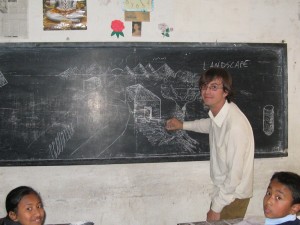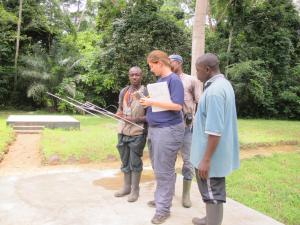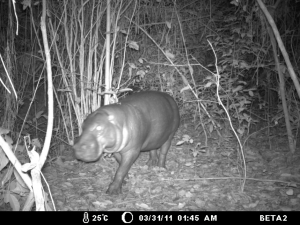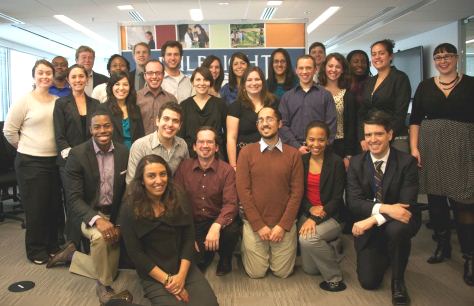U.S. Fulbrighters in South Africa, Featuring Mark Nehrenz from Fulbright Program on Vimeo.
Good Karma: Volunteering While on a Fulbright Grant in Nepal, By Franz Knupfer, 2008-2009, Nepal
March 21, 2012 When I visited the Naxal School for the Deaf on my first day in Kathmandu, the students crowded around me asking questions. “What’s your name?” they asked. “Where are you from? Are you Deaf?” I touched my index finger to my ear and then my mouth, the sign for Deaf in both Nepali and American Sign Language. I was Deaf, too, and I knew immediately that I had found a community that was willing to accept me as one of its own. In fact, I was beginning to realize that I am part of a much larger community of more than one billion people with disabilities worldwide.
When I visited the Naxal School for the Deaf on my first day in Kathmandu, the students crowded around me asking questions. “What’s your name?” they asked. “Where are you from? Are you Deaf?” I touched my index finger to my ear and then my mouth, the sign for Deaf in both Nepali and American Sign Language. I was Deaf, too, and I knew immediately that I had found a community that was willing to accept me as one of its own. In fact, I was beginning to realize that I am part of a much larger community of more than one billion people with disabilities worldwide.
The focus of my Fulbright research in Nepal was creative—I was there to work on a collection of short stories. Just as importantly, though, I knew that I wanted volunteering to be a big part of my project. In my Fulbright application, I had mentioned that I planned to teach at the Naxal School in order to find inspiration and material for my stories.
Of course, that was only part of the reason I wanted to volunteer. As a former AmeriCorps volunteer who spent two years working on environmental projects in Portland, Oregon, I knew that volunteering would help empower both the community I was working with and myself. Also, it felt good to volunteer. Volunteering gave my Fulbright experience a deeper, more fulfilling meaning that I wouldn’t have had otherwise. It gave me the opportunity to make new friends and to give back to the community that was so generously hosting me for ten months.
I volunteered to teach art and American Sign Language at the Naxal School. Soon, I discovered that my students were used to learning drawing through copying and rote memorization, just like their hearing peers in most of Asia. My goal was to teach my students to think creatively, so I taught them art techniques like shading, perspective and drawing three-dimensional objects. Eventually, I showed them how to combine all of these techniques to make a landscape, and I was rewarded one afternoon when I came into the classroom and discovered that my students had drawn a landscape on the board for me.
After school, I taught students American Sign Language and learned more Nepali Sign Language in return. During lunch breaks, I sometimes played soccer and cricket with the students. Through my experiences, I made many close friends and I also got to know a Deaf Sherpa who eventually became my guide for a month spent in the Everest region of the Himalaya. Near the end of my time in Nepal, I helped arrange an overnight camping trip around the Kathmandu Valley with ten of the older students.
While volunteering is not a requirement for a Fulbright grant, I highly recommend it. Citizen diplomacy is an important part of the Fulbright experience, and in my mind, volunteering is citizen diplomacy at its best. Fulbright grantees, with or without disabilities, may find it particularly rewarding to volunteer within the disabled community of their host country. There are many opportunities to work with people who have disabilities, especially in developing countries. Disability-related organizations and people with disabilities are helping to lead a new worldwide human rights revolution that is working towards full inclusion and participation in all aspects of society for people who have disabilities. Volunteering has the potential to leave a high impact and allows Fulbright grantees to see disability in a new context.
In Nepal, being disabled has traditionally been considered a karmic curse and people with disabilities often weren’t allowed to marry. That is gradually changing, as more people with disabilities are being included in society and are working, marrying and speaking out for their rights. While I was in Nepal, I felt anything but cursed—instead, I felt blessed to be there on a Fulbright, and by volunteering, I wanted to spread some of that good karma around.
Photo: Franz Knupfer teaches students at the Naxal School for the Deaf in Kathmandu how to draw a three-dimensional landscape.
Franz Knupfer now works as the Project Coordinator of the National Clearinghouse on Disability and Exchange, a project administered by Mobility International USA and sponsored by the U.S. Department of State. Specific resources for people with disabilities interested in applying for a Fulbright grant can be found at: http://www.miusa.org/ncde/fulbright/.
On Wednesday, February 29th, 21 newly selected Fulbright U.S. Student Program Alumni Ambassadors met in Washington, DC to receive training on how to promote and recruit for the Fulbright U.S. Student Program. Staff members from the U.S. Department of State’s Bureau of Educational and Cultural Affairs (ECA) and the Institute of International Education (IIE), along with Fulbright Alumni Ambassadors from the 2011 cohort, shared tips on giving an effective presentation and emphasized the unique, important role that Fulbright Alumni Ambassadors play in inspiring diverse students, Fulbright Program Advisers, college administrators – and anyone interested in the program – to learn more about it and the power of educational and cultural exchange.
The Fulbright U.S. Student Alumni Ambassador Program was established in 2008 to identify, train and engage a select group of approximately 15-25 Fulbright U.S. Student Program alumni to serve as representatives, recruiters and spokespersons for the Fulbright Program. They are selected annually through recommendations from Fulbright Commissions and U.S. Embassy staff, area managers, the Fulbright Student Program Outreach Division and approved by the sponsor of the Fulbright Program, the U.S. Department of State’s Bureau of Educational and Cultural Affairs. Fulbright Alumni Ambassadors come from an array of different ethnic and socio-economic backgrounds, states, fields of study, institutions and have participated in the Fulbright U.S. Student Program in all world areas.
Fulbright Alumni Ambassadors represent the program’s rich diversity and play a key role in increasing knowledge about Fulbright opportunities. They provide testimonials about their Fulbright experiences at conferences and campus presentations, and offer application tips in written articles, video and podcast interviews, webinars and at special events throughout the United States. The Fulbright U.S. Student Program relies on the Fulbright Alumni Ambassadors to share with potential applicants what the Fulbright experience is really like and how to successfully address the challenges of living abroad while meeting the Fulbright Program’s ultimate goal – to increase mutual understanding between the people of the U.S. and the people of other countries.
Here’s a preview of the 2012 Fulbright Alumni Ambassadors:
Sade Bonilla
Current City: Albuquerque, New Mexico
Undergraduate Institution: Brown University
Fulbright U.S. Student Fellow in Education – Chile, 2009-2010
Regina Cagle
Current City: Baltimore, Maryland
Undergraduate Institution: Drexel University
Fulbright U.S. Student Fellow in Energy – Ecuador, 2008-2009
Maya deVries
Current City: Berkeley, California
Undergraduate Institution: University of California, Davis
Fulbright U.S. Student Fellow in Biology – Panama, 2010-2011
Kristen Erthum
Current City: Washington, DC
Undergraduate Institution: Doane College
Fulbright English Teaching Assistant – Egypt, 2010-2011
Linnette Franco
Current City: Atlanta, Georgia
Undergraduate Institution: Agnes Scott College
Fulbright English Teaching Assistant – Spain, 2009-2010
Dustin Gee
Current City: New York, New York
Undergraduate Institution: Juniata College
Fulbright English Teaching Assistant – Montenegro, 2010-2011
Francesca Ioffreda
Current City: San Francisco, California
Undergraduate Institution: Claremont McKenna College
Fulbright U.S. Student Fellow in Economic Development – Colombia, 2010-2011
Jessica Kuntz
Current City: New York, New York
Undergraduate Institution: Georgetown University
Fulbright U.S. Student Fellow in Political Science – Croatia, 2010-2011
Samson Lim
Current City: Seattle, Washington
Undergraduate Institution: University of Washington
Fulbright U.S. Student Fellow in Education – Germany, 2010-2011
Eli Magana
Current City: Memphis, Tennessee
Undergraduate Institution: San Diego State University
Fulbright U.S. Student Fellow in Political Science – South Korea, 2009-2010
Regina Mamou
Current City: Chicago, Illinois
Undergraduate Institution: Rhode Island School of Design
Fulbright U.S. Student Fellow in Art and Architectural History – Jordan, 2009-2010
Antonio McAfee
Current City: Baltimore, Maryland
Undergraduate Institution: Corcoran School of Art
Fulbright U.S. Student Fellow in Photography – South Africa, 2009-2010
Fareed Mostoufi
Current City: Washington, DC
Undergraduate Institution: New York University
Fulbright English Teaching Assistant – Argentina, 2009-2010
Zipporah Slaughter
Current City: Atlanta, Georgia
Undergraduate Institution: Spelman College
Fulbright U.S. Student Fellow in Anthropology – Brazil, 2008-2009
Kara Spiller
Current City: New York, NY
Undergraduate Institution: Drexel University
Fulbright U.S. Student Fellow in Engineering – Portugal, 2010-2011
Sarah Staton
Current City: Washington, DC
Undergraduate Institution: William Jewell College
Fulbright U.S. Student Fellow in Chemistry – Ecuador, 2011-2012
Chase Stoudenmire
Current City: Fayetteville, Arkansas
Undergraduate Institution: University of South Carolina – Columbia
Fulbright English Teaching Assistant – Georgia, 2010-2011
Antonio Tahhan
Current City: Baltimore, Maryland
Undergraduate Institution: Cornell University
Fulbright U.S. Student Fellow in Anthropology – Syria, 2010-2011
Zane Thimmesch-Gill
Current City: Minneapolis, Minnesota
Undergraduate Institution: California Institute of the Arts
Fulbright U.S. Student Fellow in Filmmaking – Canada, 2008-2009
Michael Trice
Current City: Lubbock, Texas
Undergraduate Institution: University of Texas, Austin
Fulbright U.S. Student Fellow in Communications – United Kingdom, 2010-2011
Kelley Whitson
Current City: Glenn Dale, Maryland
Undergraduate Institution: Spelman College
Fulbright English Teaching Assistant – Malaysia, 2010-2011
Michelle Williams
Current City: Birmingham, Alabama
Undergraduate Institution: Florida A&M University
Fulbright U.S. Student Fellow in Public Health – Ghana, 2010-2011
We encourage you to check the Fulbright U.S. Student Program website in the coming weeks to read their full bios and see their photos. Ambassadors will also receive Fulbright email accounts, where you can contact them directly to ask questions about the application process.
The Fulbright U.S. Scholar Program also has a cohort of Alumni Ambassadors, selected to promote Fulbright opportunities for faculty, administrators, professionals and artists.
Photo: (Back row, left to right) Sarah Staton, Antonio McAfee, Walter Jackson (IIE), Zipporah Slaughter, Bryan Messerly (ECA), Chase Stoudenmire, Jessica Kuntz, Francesca Ioffreda, Linnette Franco, Jamie Lawrence (ECA), Kara Spiller, Michelle Williams, Sade Bonilla, Meg Neff (ECA); (second row, left to right) Maya deVries, Regina Cagle, Dustin Gee, Regina Mamou, Kristen Erthum, Zane Thimmesch-Gill; (front row) Lee Rivers (IIE), Schuyler Allen (IIE), Antonio Tahhan, Michael Trice, Fareed Mostoufi, Kelley Whitson, Tony Claudino (IIE); (not pictured) Emily Hagemeister, Justin Hill, Michelle Johnson (ECA), Mary Kirk (IIE), Kari Kuja (IIE), David Levin (ECA), Samson Lim, Eli Magana
Whether you're a Fulbright alum, student, musician, flimmaker – or all four – stop by the Fulbright Program's trade show exhibition at SXSW from March 12-15 (stand 930) to learn more about grant opportunities.
The Fulbright Program increases mutual understanding between the people of the United States and the people of other countries. It supports individuals in all fields to undertake innovative projects, while also enabling participants to become cultural ambassadors from their countries.
Projects can include study, field research and teaching (at all levels). For example, Fulbrighters have:
– Developed devices to detect cancer by scent
– Used music to help children with HIV create a supportive community
– Studied new painting techniques
– Developed key new economic theories
– Taught Arabic to U.S. college students
– And over 300,000 other projects in more than 150 countries
The Fulbright Program is sponsored by U.S. Department of State, Bureau of Educational and Cultural Affairs. For more information, visit: http://fulbright.state.gov/.
This Sunday, March 11 in Austin, Texas, the Fulbright Program will present a panel within the very popular SXSW Interactive track entitled “Fulbright: How the 1st Social Network Adapts to Social Media.” The panel will be moderated by Meg Neff, Public Affairs Assistant, Bureau of Educational and Cultural Affairs, U.S. Department of State, Vijay Renganathan, Senior Program Officer, the Institute of International Education, Doug Mitchell, Fulbright Scholar Specialist to Chile and Katie Day Good, Fulbright-mtvU Student to Mexico, 2008-2009, as panelists. To learn more, please visit the SXSW schedule of events.
Like last year, the Fulbright Student and Scholar Programs will be represented by a booth during the tradeshow from March 12-15. We hope you will stop by and learn more about Fulbright’s involvement in SXSW!
Pygmy Hippos: The Real Diamonds of Sierra Leone, By April Conway, 2010-2011, Sierra Leone
February 29, 2012 My journey began when I travelled to the remote Tiwai Island Wildlife Sanctuary located on the Moa River in Sierra Leone. I set out to study the endangered pygmy hippopotamus (Choeropsis liberiensis), a very solitary and elusive animal that is notoriously difficult to study in the wild. Armed with 20 remote-sensing camera traps, my goal was to capture pygmy hippos on film. In addition to obtaining photographs, I explored methods to physically trap a pygmy hippopotamus so that we could attach a collar and track the animal through the forest. To raise awareness for the plight of the pygmy hippopotamus, I collaborated with several conservation organizations to conduct environmental education in schools and villages.
My journey began when I travelled to the remote Tiwai Island Wildlife Sanctuary located on the Moa River in Sierra Leone. I set out to study the endangered pygmy hippopotamus (Choeropsis liberiensis), a very solitary and elusive animal that is notoriously difficult to study in the wild. Armed with 20 remote-sensing camera traps, my goal was to capture pygmy hippos on film. In addition to obtaining photographs, I explored methods to physically trap a pygmy hippopotamus so that we could attach a collar and track the animal through the forest. To raise awareness for the plight of the pygmy hippopotamus, I collaborated with several conservation organizations to conduct environmental education in schools and villages.
 I spent almost every moment with my two local field assistants. We worked together in the forest and travelled around the countryside to explore areas for hippos. While we worked, we discussed all aspects of our cultures, trying to understand the differences and find where we had common ground. These men became my brothers, and the villagers, my second family. Kenewa, one of my field assistants, loaned me his grain storage room to sleep in when I needed some “people time” off the island. He carved my name into the door and declared the room would always be mine, no matter where I was in the world.
I spent almost every moment with my two local field assistants. We worked together in the forest and travelled around the countryside to explore areas for hippos. While we worked, we discussed all aspects of our cultures, trying to understand the differences and find where we had common ground. These men became my brothers, and the villagers, my second family. Kenewa, one of my field assistants, loaned me his grain storage room to sleep in when I needed some “people time” off the island. He carved my name into the door and declared the room would always be mine, no matter where I was in the world.
 Although work took up much of our time, my team and I would sometimes go to the local dances. Dee-jays would set up shop in a village meeting area and we would dance the night away. The relationships I developed gave me a unique perspective on conservation. I witnessed the frustrations that wildlife conservation can bring in an area where people are struggling daily for survival. I have learned to enjoy every day as it comes and cherish relationships. I have also learned to work better with people, to maintain patience even when things are difficult, to manage employees and to try to understand all sides of conflicts before making a decision. By employing over 60 local people over the course of my research, the villages began to see some benefits for conserving the island.
Although work took up much of our time, my team and I would sometimes go to the local dances. Dee-jays would set up shop in a village meeting area and we would dance the night away. The relationships I developed gave me a unique perspective on conservation. I witnessed the frustrations that wildlife conservation can bring in an area where people are struggling daily for survival. I have learned to enjoy every day as it comes and cherish relationships. I have also learned to work better with people, to maintain patience even when things are difficult, to manage employees and to try to understand all sides of conflicts before making a decision. By employing over 60 local people over the course of my research, the villages began to see some benefits for conserving the island.
Fulbright enabled me to interact with and influence hundreds, if not thousands, of people. I am a stronger person when dealing with adversity and have come through the experience with a new insight into the world. I also obtained some great results for my research: video footage of pygmy hippos eating and pictures of animals never before documented on the island including the majestic bongo. The highlight of my research was when the U.S. Ambassador came to visit the island for a night, and the villagers put on a fantastic cultural show complete with a ‘pygmy hippo devil.’
My advice to those applying for a Fulbright grant is:
- Pick a project that is your passion. This is your time to do what you want!
- Tell a story with your personal statement and explain your project in a way comprehensible to those outside your specialty (no jargon!).
- In country, try to do an extra project outside of your own research. You’ll meet new people and maybe have an adventure you never expected.
Top photo: April Conway, 2010-2011, Sierra Leone (center), training local field assistants in radio telemetry techniques that track wildlife through the forest using radio waves
Middle photo: A pygmy hippopotamus caught on camera on Tiwai Island
Bottom photo: April Conway, 2010-2011, Sierra Leone (left), with women preparing rice flour for a funeral in Kambama village

